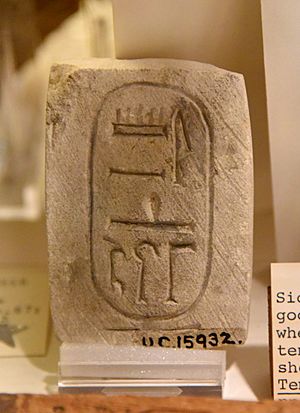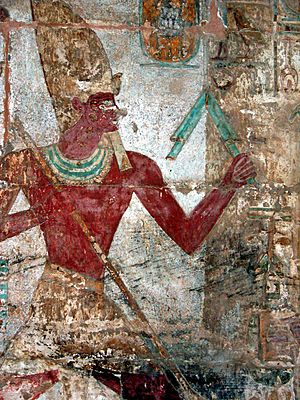Amenhotep II facts for kids
Quick facts for kids Amenhotep II |
|
|---|---|
| Amenophis II | |

Large statue head of Amenhotep II on display at the Brooklyn Museum.
|
|
| Pharaoh | |
| Reign | 1427–1401 BC or 1427–1397 BC (18th Dynasty) |
| Predecessor | Thutmose III |
| Successor | Thutmose IV |
| Consort | Tiaa |
| Children | Thutmose IV, Amenhotep, Webensenu, Amenemopet, Nedjem, Khaemwaset?, Aaheperkare? Aakheperure? Iaret, Ahmose (?) |
| Father | Thutmose III |
| Mother | Merytre-Hatshepsut |
| Died | 1401 or 1397 BC |
| Burial | KV35 |
Amenhotep II (also known as Amenophis II) was the seventh pharaoh of ancient Egypt's 18th Dynasty. His name means "Amun is Satisfied."
Amenhotep II took over a huge kingdom from his father, Thutmose III. He kept control of it through a few military trips to Syria. However, he didn't fight as much as his father. During his rule, the fighting between Egypt and Mitanni (two major powers in Syria) mostly stopped. Historians usually say he ruled from 1427 to 1401 BC. His main wife was Tiaa. She didn't gain much power until their son, Thutmose IV, became pharaoh.
Contents
Family and Early Life
[[File:Foundation tablet showing the prenomen cartouche of the throne-name of Amenhotep II. 18th Dynasty. From Temple of Amenhotep II at Kurna, Egypt. The Petrie Museum of Egyptian Archaeology, London. With thanks to the Petrie Museum of Egyptian Archaeology, UCL.jpg|thumb|left|This tablet shows Amenhotep II's throne name.]]
Amenhotep II was the son of Thutmose III and a queen named Merytre-Hatshepsut. He wasn't his father's first son. His older brother, Amenemhat, was supposed to be the next pharaoh. But both Amenemhat and his mother died. This led Thutmose III to marry Merytre-Hatshepsut, and Amenhotep II became the heir.
Amenhotep II grew up in Memphis in northern Egypt, not in the traditional capital, Thebes. As a prince, he helped manage important tasks, like overseeing wood deliveries. He also became a high priest in Lower Egypt.
Athletic Skills
Amenhotep II was known for his amazing athletic abilities. He claimed he could shoot an arrow through a thick copper target. He also said he could row his ship faster and farther than 200 navy members. Some historians wonder if these stories are completely true.
Becoming Pharaoh
Amenhotep II became pharaoh shortly after his father's death. He may have ruled alongside his father for about two years before becoming the sole king. When he officially took the throne, he was 18 years old.
After becoming pharaoh, Amenhotep II married Tiaa. They had several children, including Thutmose IV, who would become the next pharaoh. Other sons included Amenhotep, Webensenu, Amenemopet, and Nedjem. He might have also had a daughter named Iaret.
How Long Did He Rule?

Historians can figure out when Amenhotep II became pharaoh because of records from his father's reign. He likely started ruling around 1427 BC. We know he ruled for at least 26 years. A wine jar found in his temple was dated to his 26th year. This suggests he didn't live much longer than that.
Some theories suggest he ruled for up to 35 years. However, X-ray analysis of his mummy shows he was about 40 years old when he died. This means a 26-year reign (from 1427 to 1401 BC) is the most accepted idea.
Foreign Affairs and Campaigns

Amenhotep II led his first military campaign in his third year as pharaoh. He faced an attack from the army of Qatna while crossing the Orontes river in Syria. He won the battle and took many valuable items. He was known for his strength and is said to have personally killed seven rebel princes at Kadesh.
After this victory, he ordered the bodies of the seven princes to be hung on the front of his ship. When they reached Thebes, six princes were displayed on the city walls. The seventh was taken to Nubia and hung on the wall of Napata. This was a warning to anyone who thought about rebelling against Egypt.
Later Campaigns and Peace
In his seventh year, Amenhotep II faced a big rebellion in Syria. This was likely started by Mitanni, Egypt's main rival in the Near East. His victory tablet from this campaign doesn't mention any major battles. This might mean he mostly toured the area, making cities promise loyalty.
His last campaign was in his ninth year, but it didn't go further north than the Sea of Galilee. He claimed to have captured over 100,000 slaves from this campaign. However, these numbers are likely exaggerated or include combined figures from earlier campaigns.
After this ninth-year campaign, Mitanni wanted to make peace with Egypt. From then on, their armies never fought again. Amenhotep claimed that kings from Babylon, the Hittites, and Mitanni came to pay him tribute. While this might be an exaggeration, there is evidence that Mitanni sought peace.
The rising power of the Hittites probably made Mitanni look for an ally. A treaty between Egypt and Mitanni was likely made during or after Amenhotep's rule. This peace helped both nations. Mitanni could focus on threats from the Hittites and Assyrians. Egypt could get more resources from Syria and Palestine and access Mediterranean trade routes. After this, Amenhotep focused mostly on matters within Egypt.
Building Projects
Amenhotep II's father, Thutmose III, had spent a lot of effort building up Karnak. So, Amenhotep II focused on making smaller temples bigger all over Egypt. In the Nile Delta, his chief builder, Minmose, oversaw new construction. In Upper Egypt, small shrines were built at Medamud, el-Tod, and Armant.
Karnak still received some attention. Amenhotep II ordered a column to be built there to celebrate receiving tribute from Mitanni. In Nubia, he built at Qasr Ibrim and Semna. He also ordered decorations for the Temple at Kalabsha. His most famous Nubian temple was at Amada. His father had started this temple, and Amenhotep II finished it. He placed a stone tablet (stele) there, recording his third-year military campaign.
He also had a mortuary temple built near the Theban Necropolis. This temple was unfortunately destroyed a long time ago.
Personality and Later Life
A stone tablet from Amenhotep II's later years shows his strong feelings about non-Egyptians. This document is a copy of a letter he wrote to Usersatet, his governor of Kush (Nubia). In the letter, Amenhotep II reminded Usersatet of their military victories together in Syria. He then criticized how Usersatet was doing his job.
Usersatet was so impressed (or scared) by Amenhotep's message that he had a copy of it carved onto a stone tablet. This tablet is now in the Boston Museum of Fine Arts.
Amenhotep II didn't openly record the names of his queens. Some historians believe he thought women had become too powerful in titles like God's Wife of Amun. They point out that he helped his father remove Hatshepsut's name from her monuments. This might show a concern that another woman would try to rule as pharaoh.
Amenhotep II also brought many Canaanite gods into the Egyptian religion. These included gods like Resheph, Hauron, Baal, Astarte, and Qetesh.
Death and Burial
Amenhotep II was buried in his tomb, KV35, in the Valley of the Kings. His mummy was found there in its original sarcophagus in 1898. The tomb also held the mummies of several other pharaohs, including Thutmose IV, Seti II, Ramesses III, Ramesses IV, and Ramesses VI. These pharaohs had been moved to Amenhotep II's tomb later to protect them from tomb robbers.
His Mummy
Grafton Elliot Smith examined Amenhotep's mummy in 1907. He found the pharaoh was about 1.67 meters (5 feet 6 inches) tall. He also noticed that Amenhotep II looked a lot like his son, Thutmose IV. The mummy had wavy brown hair with a lot of white strands. His arms were crossed over his chest.
Smith estimated that Amenhotep II was between 40 and 50 years old when he died, based on his worn teeth and graying hair. The exact cause of his death is not known.
In April 2021, Amenhotep II's mummy was moved from the Museum of Egyptian Antiquities to the National Museum of Egyptian Civilization. This was part of a big event called the Pharaohs' Golden Parade, where 17 other kings and 4 queens were also moved.
See Also
 In Spanish: Amenofis II para niños
In Spanish: Amenofis II para niños








